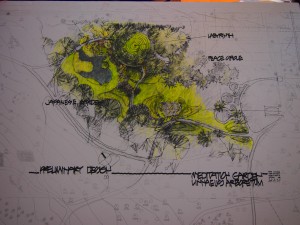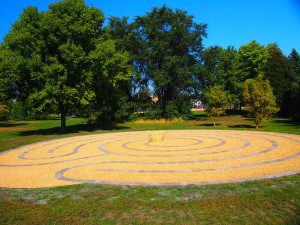The completion of a Swedish Labyrinth near the entrance of the Linnaeus Arboretum marked the first stage of constructing meditative gardens on campus.
Current Linnaeus Arboretum Director and Naturalist Scott Moeller discussed how students currently utilize the arboretum.
“The arboretum is here primarily for education, but is also here for recreation, relaxation, and reflection. One thing that I’m always working on is making sure that students are aware of the arboretum and what it can offer,” Moeller said.

The Meditation Gardens have been in the works for a few years and will consist of the Swedish Labyrinth, a peace circle from Native American tradition, and a Japanese garden.
The seeds for Meditation Gardens began when Previous Linnaeus Arboretum Director and Biology and Environmental Studies Professor Cindy Johnson convened a committee of individuals that included former Chaplain Rachel Larson, Physical Plant Director Warren Wunderlich, and landscape architect Herb Baldwin, who has worked with Gustavus on over forty projects and designed the initial sketches for the gardens.
“As [previous] Director of the Arboretum, I wanted to lay out a forward plan. As we sat down and discussed plans, it became clear that we didn’t want just one garden. We wanted a set of gardens that would reflect many traditions,” Johnson said.
Swedish labyrinths traditionally consist of stones or boulders set into the soil in a circuluar or spiral pattern, with an entrance that doubles as an exit located on the south side. The oldest Swedish labyrinths were found on the Baltic coastline.
“The labyrinth is designed to be an individual reflective tool. It reflects the Swedish heritage of the college,” Johnson said.
The foundation of the Swedish Labyrinth was completed this past summer and was funded by a Coca-Cola grant. The labyrinth will be fully completed with the addition of a plaque and collection of stones that you can take with you as you travel thrugh the labyrinth.
“The walker of the labyrinth will use the labyrinth as a tool and find clarity and peace through it,” Moeller said.
The labyrinth will serve the purpose of invidual reflection.
“The idea is that you approach it from the bigness of our world and carefully walk through the path. As you do that, you are coming into your own being, and focusing on yourself, and finding and being you. It is coming into the essence of you. And as you step back out, you return back into the world,” Johnson said.
Johnson credits former Chaplain Rachel Larson for the Swedish Labyrinth as she researched and secured funding that enabled the completion of the structure.
“Rachel is somewhat of an expert on labyrinths. She had one that rolled out and used as a [tool for reflection]. We wanted very much to have one outside and this came from her effort,” Johnson said.
 In addition to the labyrinth, a Native American peace garden and Japanese meditative garden will complete the scheme of the Meditation Gardens.
In addition to the labyrinth, a Native American peace garden and Japanese meditative garden will complete the scheme of the Meditation Gardens.
The Native American peace garden was designed to represent people and reflect the land of those who existed on the land prior to Swedish immigration during the late 19th century. The garden will likely feature a peace pole with native rocks where people can gather.
The Japanese meditation garden represents a more forward way of thinking and reflects a more recent immigration of Asian communities. This garden will incorporate the existing Gilbert Teaching Pond and such Japanese garden elements of benches, pebbles, and shrubs. It will serve as a serene space for reflection.
An existing independent natural meditation area located in the coniferous woods of the arboretum was designed years ago using Chinese elements and feng shui concepts.
“What we wanted was a set of meditative gardens that function as reflective spaces for both individuals and groups. Our other concern was connecting to our heritage [and values]. We thought a lot about accessibility and having it open to everyone,” Johnson said.
Johnson and Moeller hope the gardens will serve as an educational purpose.
“We have [inadequate] outdoor teaching spaces on campus and this would be great to fix that. I can totally envision having a class there and sending students to reflect on their own in the space,” Johnson said.
Currently, there are no definitive plans to complete the Native American peace garden and the Japanese garden in the meditative area as funding has yet to be secured by a donor.
Johnson mentioned the purpose and utility of having meditative spaces on college campuses.
“[The Meditation Gardens will serve] as a really important way that we can get at some of the things that we struggle with. It’s a tool for meditation and reflection, and to get closer to a truth that we are seeking. We all struggle with different things and finding a space that is quiet where we can go inward is hard in our crazy world,” Johnson said.